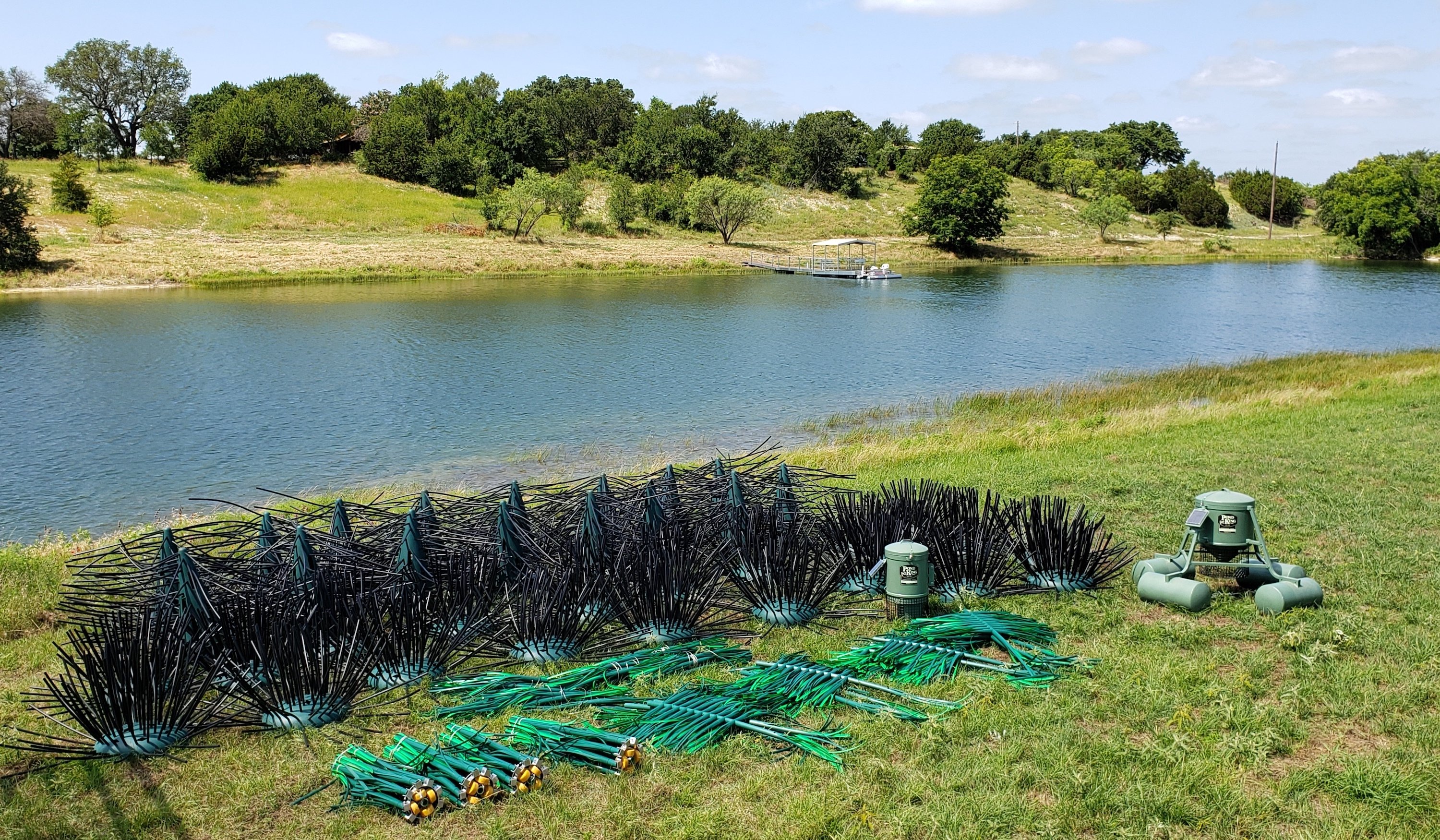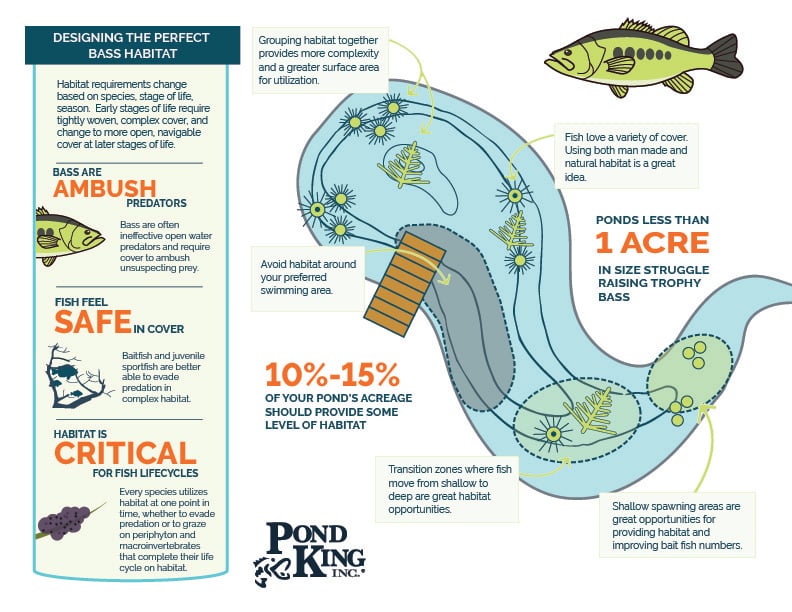When it comes to defining the scope of any habitat improvement project, the first step is to evaluate the amount of cover currently available.
What Constitutes Fish Habitat?
Fish habitat can consist of several components that can occur naturally or artificially in ponds and lakes.
Often hard structural cover, such as
- Submerged trees
- Brush piles
- Rock piles
And highly dynamic soft cover, such as:
- Aquatic vegetation
- Habitat created by the bottom contour of the pond
- Examples of these are:
- Drop-offs
- Ledges
- Points
- Examples of these are:
Determine the Total Cover Area Needed for Your Pond
Once you have determined the total surface area provided by the currently available cover, you need to divide this amount by your lake or pond's total area. This will give you the proportion of the fishery that has some habitat availability.
For an ideal Bass fishery, this proportion needs to be 10-15% of the pond or lake's total surface area, and for Trophy Bass Production, it needs to be at the higher end of this spectrum.
Now you can determine the extent of habitat improvements necessary by taking the recommended proportion and subtracting the amount of habitat currently present. This will give a foundation to start your improvement efforts.
Assess the Habitat throughout the Water Column
Next you need to evaluate at what depth in the water column these natural structures occupy. Habitat availability in all portions of the water column is key to a productive, sustainable fishery.
Can’t I Just Place a Shallow Cover to Hold My Bass?
Having habitat in only the shallow areas or brush piles in moderate to deep water doesn't fill all your game fish's needs, as they regularly occupy varying water depth throughout their seasonal movements.
Think about it, as Bass get ready to spawn in the spring, they move from deeper water to "staging" areas in moderate water depths to build resource reserves before they begin guarding beds. As they get closer to spawning, they move again up into shallow areas to build beds and reproduce.
After this, it's no holds barred. They are in all regions of the water column looking for their next meal, utilizing habitat to be the most efficient predators they can be.
Protect Your Fry and Juvenile Fish with Adequate Cover
Not only that, but look at the habitat needs for your fry and juvenile fish. Once they hatch, everything in or around the fishery is trying to eat them. They need adequate cover in the shallow areas to evade predation until they can grow and begin venturing into deeper areas.
Even once they are out in deeper areas, they need some sort of cover to reach a size where they are either more useful to your fisheries population or at less likely risk of predation.
Assess the Habitat at Various Water Depths
Finally, determine the type of habitat that is present in these varying water depths. Having only one type of cover available can potentially tip the scales to benefit only one group or life stage of your fisheries community.
Take, for example, having habitat only provided by aquatic vegetation, specifically American Pondweed.
American Pondweed is an excellent form of complex natural aquatic vegetation that both your forage and larger predator species can both utilize. However, if proper water clarity is being controlled, American Pondweed will only grow in 4-6' of water.
This leaves the entire moderate to deep water zones of your pond empty of available cover.
Prepare for Winter Months When Natural Fish Cover Dies Off
In addition to that, aquatic vegetation dies off during the winter months and then takes a few months to reach sufficient levels to benefit your predators next spring.
This is where having a diverse offering of complex habitat in all portions of the water column is crucial to your fishery. Hard structural coverage in the shallow portions of your pond or lake not only creates a fish attractor during the spring but also provides shallow-water cover even during the winter months.
Consider the Rate of Decay for Natural Cover Like Standing Timber
When evaluating stands of flooded timber, be sure you are considering the amount of habitat complexity beneath the water and not what is above it. The wood above the water decomposes at a much slower rate than that beneath the water. This can give you the impression of having a highly desirable, complex habitat. Whereas the real situation is a simple vertical structure is all that is being provided to your fish.
Plan Your Habitat Installation(s)

With this information, you can determine the exact areas and types of cover your fishery needs to maximize its productivity. Assessing this information can feel a bit daunting, especially when you realize that a large amount of improvement needs to be done.
When our fisheries biologists work with customers in this type of situation, we'll often develop a multi-season plan to add incremental amounts of habitat to achieve the desired result.
Would Improving Pond Habitat in One Attempt be an Option?
Yes, the quickest path to achieve your goals may be altering the current situation all at once, but sometimes the sheer size of a lake or budget availability of a client doesn't allow for this.
What is the Best Way to Improve a Private Pond’s Habitat?
Spreading habitat improvements over a few years will allow you to manage your fishery without feeling overwhelmed. When it comes to habitat improvements, any additional structures are better than none. Even a small improvement to the habitat availability will take you a step closer to reaching that recommended amount, as well as adding additional fishing honey holes.
However, it is important to note that if a Trophy Bass Fishery is your goal, the longer you spread out your efforts, the longer it will take to catch that once-in-a-lifetime fish.
A Caveat to a Lake’s Hard Structure Management
Speaking of the types of hard structural cover available, it is important to consider low water conditions. In lakes where the water level fluctuates, you can have adequate habitat availability during times of normal water levels. Then, as the water begins to drop in the summer or winter, the structure may still be in the water, but a portion of it is unusable to your fish.
We experience this quite frequently here in Texas. There are a couple of ways to combat this condition. Install additional structures that account for this dropping water level or utilize highly dynamic artificial habitat to move with the receding water.
We designed the Honey Hole series with this situation in mind. These structures are made of buoyant material, so they float and move with the current water level but are still anchored to the pond floor to stay where you put them. With their buoyant nature, these structures will lower with the dropping water level and maximize the amount of available cover for a longer period of time.
Continue Adding Fish Habitat Over Time
Ensuring your pond or lake has adequate habitat availability is vital to reaching your fisheries goals. Through this detailed evaluation, you can pinpoint exactly where your current habitat availability is lacking and maximize the results of your efforts.
While it can seem overwhelming at times, it is important to remember that even small habitat additions are steps in the right direction. Any habitat additions are better than doing nothing at all.
Contact Pond King for Professional Pond Habitat Management
If you have any questions about habitat improvement on your personal fishery or how to evaluate your current available habitat, feel free to contact us at or give our team a call to see how the fisheries biologists of Pond King can help you!
See y'all down at the pond.





